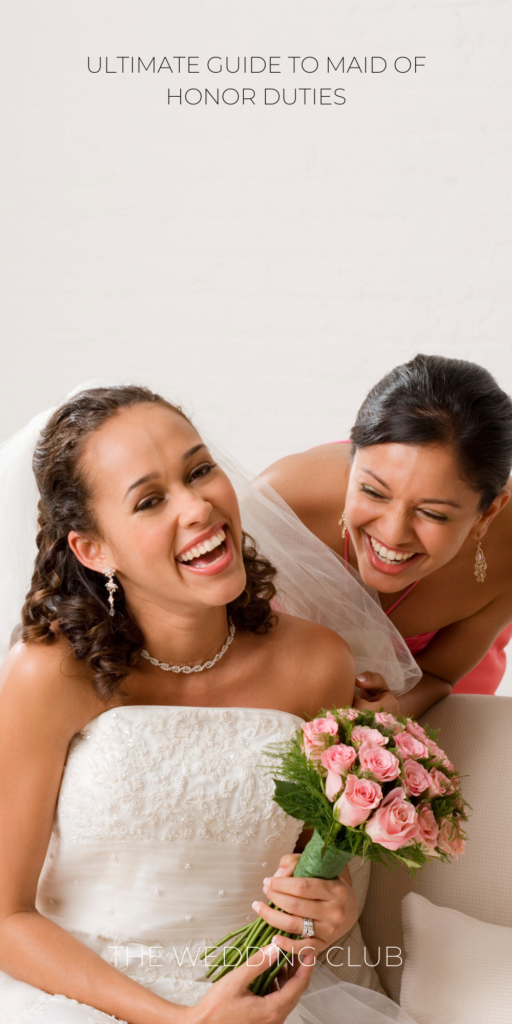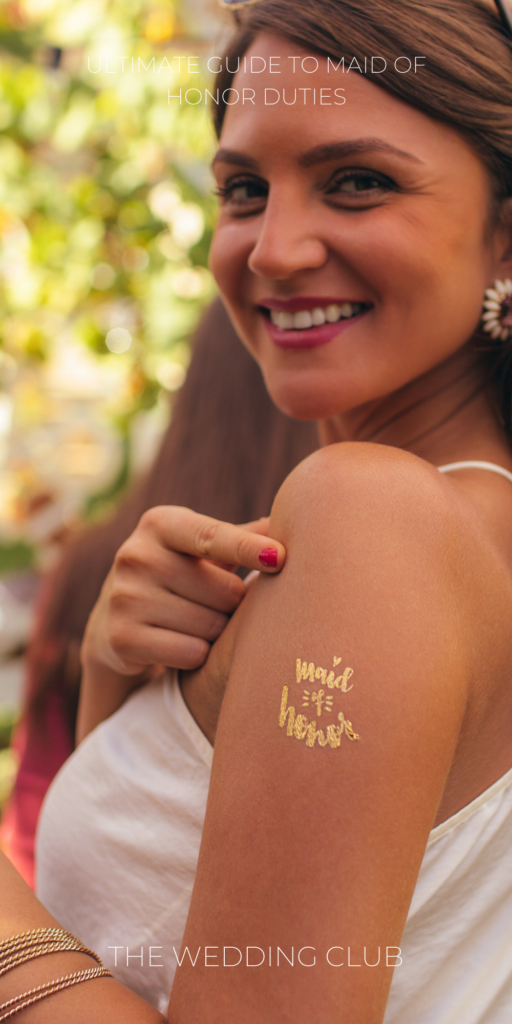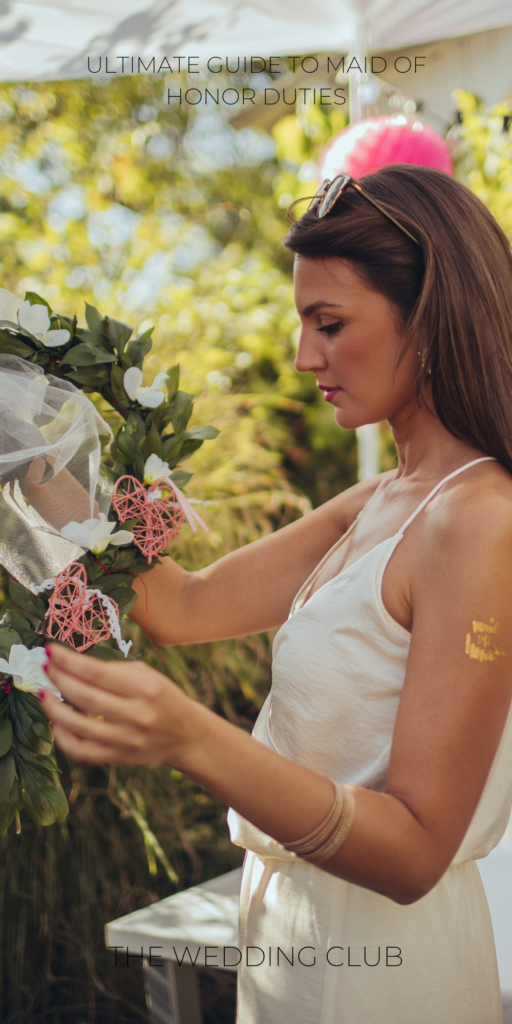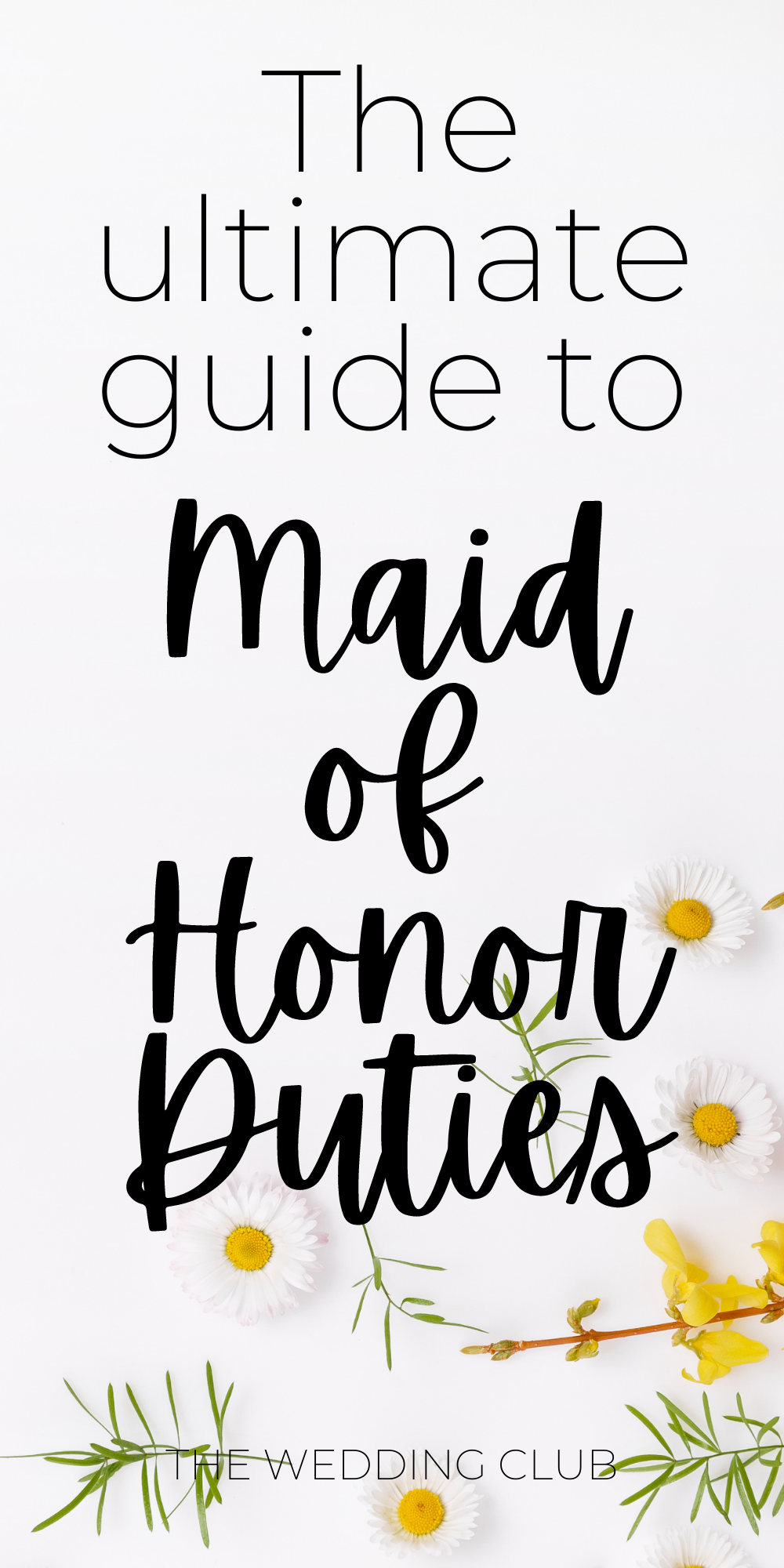Whether you’re a seasoned maid of honor or new to the role, this article will provide you with valuable insights, practical tips, and a detailed checklist to help you navigate through the wedding planning process with confidence.
From organizing pre-wedding events like the bridal shower and bachelorette party to assisting with dress fittings, managing the wedding timeline, and offering emotional support, we cover it all.
So, get ready to embrace your role as the bride’s right-hand woman and create unforgettable memories as the ultimate maid of honor.

Everything you need to know about the Maid of Honor's Duties and Responsibilities
If you’ve been chosen as the maid of honor for an upcoming wedding, congratulations! As the bride’s trusted companion and confidante, you have a pivotal role to play in ensuring her special day is nothing short of perfection.
But before you dive right in and swamp yourself with a huge checklist of things you think will be expected from you, it’s super important to establish with the bride how much she actually expects from you and what your level of involvement should be.
So before creating your checklist, have a first meeting with the bride so that you can both establish all of this.

1. Provide emotional support
…and be a reliable confidante for the bride throughout the wedding planning process.
Actively listen to her ideas, concerns, and wedding-related thoughts. Offer words of encouragement, provide reassurance, and help alleviate any stress she may be experiencing
2. Assist the bride in choosing her wedding dress and bridesmaid dresses
Accompany the bride when she goes wedding dress shopping and offer your opinions and support.
Help her find a dress that matches her vision and makes her feel beautiful. Additionally, you may assist with choosing bridesmaid dresses, ensuring they complement the wedding theme and the preferences of the bride.
Here are some helpful tips for assisting the bride in choosing her wedding dress and bridesmaid dresses:
- Understand the bride’s vision – Ask about her preferred style, color palette, and overall theme. This will help you narrow down dress options that align with her preferences.
- Do some research – Familiarize yourself with different wedding dress styles and bridesmaid dress trends. Look through bridal magazines, online platforms, and social media to gather inspiration and ideas.
- Accompany the bride to all her dress appointments – This way, you can provide moral support and offer your input as she tries on different dresses and doing alterations.
- Consider the wedding venue and theme – Take into account the wedding venue and theme when helping to select dresses. Ensure that the bridesmaid dresses complement the bride’s dress and the overall wedding aesthetic.
- Keep the budget in mind – Consider factors like alterations, accessories, and any additional costs when making final decisions. It’s important to respect everyone’s financial situations.
- Think about body types and preferences – Look for dress styles that flatter a variety of body shapes and sizes. Consider options like mix-and-match dresses to accommodate different preferences and ensure everyone feels comfortable and confident.
- Plan ahead for alterations – Wedding dresses often require alterations to achieve the perfect fit. Discuss the timeline and necessary alterations with the bride and bridesmaids to allow ample time for fittings and adjustments.
- Coordinate with the bridesmaids – Communicate with the bridesmaids to gather their input and preferences. Consider organizing a dress shopping day or virtual session to involve them in the decision-making process.
- Document dress details – Take photos or keep a record of the chosen dresses, including style numbers, colors, and any specific details. This will help with coordination for future fittings, ordering accessories, and communicating with vendors. The wedding planner includes sheets for exactly this purpose.
- Enjoy the process – Dress shopping should be a fun and exciting experience. Encourage the bride to try on different styles and enjoy the moment. Celebrate each step of the journey and support her in finding a dress that makes her feel absolutely radiant on her special day.
Remember, the bride’s happiness and comfort should always be the top priority when assisting in choosing wedding dresses. Your role is to offer guidance, support, and ensure that the bride’s vision comes to life while keeping the bridesmaids’ preferences in mind as well.
3. Help with organizing and planning pre-wedding events
This includes helping with the bridal shower and bachelorette party, and so on.
Collaborate with the other bridesmaids and the bride’s family to plan and execute memorable pre-wedding celebrations.
This can involve selecting venues, creating guest lists, sending out invitations, coordinating decorations, and organizing activities or games that suit the bride’s interests and personality.
4. Coordinate with other bridesmaids and family members
Ensure everyone is aware of important dates and responsibilities.
Serve as a point of contact and keep everyone involved informed about key wedding-related dates, such as dress fittings, rehearsal dinners, and the wedding day itself.
Be clear in your communication and double-check that everyone is on the same page and know what is expected of them.
A note on handling drama:
Handling family drama can be challenging, but as the maid of honor, you can play a vital role in keeping the peace and ensuring a harmonious wedding experience. Here are five tips to help you navigate family drama:
Maintain open and empathetic communication – Act as a mediator and encourage open and honest communication among family members. Listen to their concerns and feelings with empathy, and strive to find common ground. Sometimes, people just need to be heard and understood to defuse tensions.
Stay neutral and avoid taking sides – As the maid of honor, it’s crucial to remain neutral and avoid favoritism. Refrain from taking sides or engaging in gossip or negative talk about any family members.
Set boundaries and redirect conversations – If you find yourself in the middle of family conflicts or tense discussions, tactfully redirect the conversation to more positive or neutral topics. Gently guide the focus back to the wedding, celebration, or shared happy memories. Encourage everyone to remember the significance of the occasion and put aside personal differences.
Offer assistance and delegate tasks – One way to mitigate family drama is to keep everyone engaged and involved in constructive activities. Assign tasks and responsibilities to different family members, ensuring they feel included and valued. By working together towards a common goal, tensions may ease, and the focus can shift to collaborative efforts.
Encourage compromise and find win-win solutions – In situations where conflicts arise, strive for compromise and win-win solutions. Help family members find common ground and facilitate discussions to reach mutually acceptable agreements. Emphasize the importance of maintaining family harmony during such a special time and encourage everyone to put aside differences for the sake of the couple’s happiness.
Remember, it’s essential to prioritize the happiness and well-being of the couple throughout the process. If the family drama becomes overwhelming or unmanageable, consider involving a trusted wedding planner or seeking professional guidance to help navigate through the challenges effectively.
5. Attend dress fittings and alterations appointments
Accompany the bride and bridesmaids to dress fittings and alterations appointments to provide support and input. This helps ensure that the dresses fit properly and are ready for the big day. Provide feedback on the fit and style, and communicate any necessary adjustments to the seamstress or tailor.

6. Help address and send out wedding invitations, as well as manage RSVPs
Assist the bride in the process of addressing and sending out wedding invitations.
This may involve organizing guest lists, addressing envelopes, and ensuring that the invitations are mailed on time. Additionally, help track and manage RSVPs, keeping an updated count of confirmed guests for the wedding.
If the bride doesn’t already have one, the wedding planner is the ideal tool to plan out and assist with every wedding detail, including guest list management, the wedding budget, and a very helpful wedding venue workbook.
7. Assist with creating and managing the wedding budget
Collaborate with the bride and other key parties involved to establish a realistic budget for the wedding.
Help track expenses, compare vendor prices, and find cost-saving opportunities. This can include researching and obtaining quotes from different vendors, negotiating contracts, and keeping financial records organized.
8. Help with wedding decoration ideas and themes
Work with the bride to brainstorm and develop ideas for wedding decorations and themes.
This can involve researching decor options, providing suggestions, and assisting with the setup and arrangement of decor elements on the wedding day.
9. Coordinate transportation for the wedding day
…including arranging transportation for the bridal party.
Help organize transportation logistics for the wedding day. This may include arranging transportation for the bride, groom, and the bridal party from the preparation location to the ceremony venue and reception.
Coordinate with transportation providers, confirm arrival times, and ensure everyone arrives at the designated locations on time.

10. Help the bride with wedding day preparations
This can include things like getting dressed, doing hair and makeup, and putting on the veil.
Help her get into her wedding dress, fastening buttons or zippers, and ensuring that her hair and makeup are flawless. You may also help her put on her veil, jewelry, and other accessories.
11. Hold the bride's bouquet during the ceremony
During the wedding ceremony, you may be responsible for holding the bride’s bouquet while she exchanges vows or participates in certain rituals.
This allows her to have her hands free and ensures the bouquet is safely managed.
12. Arrange and adjust the bride's train and veil during the ceremony
Ensure that the bride’s train and veil are properly arranged and adjusted as she walks down the aisle or moves around during the ceremony.
This includes smoothing out the train, arranging the veil, and ensuring that everything looks picture-perfect.
13. Assist the bride with any last-minute needs or requests on the wedding day
Be attentive and responsive to the bride’s needs on her wedding day.
This can involve fetching items, running errands, coordinating with vendors, and addressing any unforeseen issues that may arise. Your role is to help make the day as stress-free and enjoyable as possible for the bride.
Here’s a simplified list of some of the bride’s last-minute needs or requests on the wedding day:
- Keeping her hydrated and nourished.
- Assisting with dress adjustments.
- Helping with restroom breaks.
- Gathering any forgotten or misplaced items.
- Providing emotional support and calming nerves.
- Coordinating with vendors and troubleshooting issues.
- Managing the timeline and keeping everyone on schedule.
- Capturing candid moments through photos.
- Providing a touch-up kit for quick fixes.
- Being a supportive presence throughout the day.
By fulfilling these last-minute needs, you can help ensure that the bride has a smooth and stress-free wedding day.
14. Coordinate with the wedding planner and vendors to ensure everything runs smoothly
Work closely with the wedding planner, as well as other vendors involved in the wedding, to ensure that all the logistics are well-coordinated.
This includes confirming timelines, communicating any changes or updates, and addressing any concerns or issues that may arise during the planning process or on the wedding day.

15. Keep track of the wedding timeline and ensure that events are on schedule
Stay informed about the wedding day timeline and help keep everyone on track.
Remind the bride, bridal party, and other key individuals of upcoming events, such as the ceremony, speeches, and reception activities.
Help ensure that everyone is aware of the schedule and that everything runs smoothly and according to plan.
Here’s a general outline of a day-of wedding schedule:
Morning:
- Hair and makeup: The bride and bridal party start getting ready with hair and makeup artists. Allow ample time for each person to be styled and dressed.
- Photographer and videographer arrival: Coordinate with the photographer and videographer to arrive during the preparation time to capture candid moments and details.
Mid-Morning to Afternoon:
- Groom and groomsmen preparations: The groom and groomsmen get ready, ensuring they have sufficient time for grooming, dressing, and any pre-ceremony photos.
- Final touches: The bride and bridal party complete their hair, makeup, and final dressing adjustments.
- Wedding party and family photos: Schedule time for formal group photos with the wedding party and immediate family members.
Late Afternoon:
- Ceremony setup: Ensure that the ceremony venue is set up with decorations, seating arrangements, and any special elements.
- Guest arrival: Guests begin to arrive at the ceremony venue. Have ushers or designated greeters available to welcome and assist them.
Ceremony:
- Processional: The wedding party, including the maid of honor, walks down the aisle.
- Bride’s entrance: The bride walks down the aisle with her escort.
- Vows and exchange of rings: The couple exchanges vows, rings, and any other ceremony rituals.
- Pronouncement and recessional: The couple is pronounced married, and they exit the ceremony venue together, followed by the wedding party.
Post-Ceremony:
- Cocktail hour: Guests enjoy drinks and hors d’oeuvres during the cocktail hour while the couple takes formal photos.
- Reception setup: Coordinate with the wedding planner or venue staff to set up the reception area, including tables, centerpieces, and decor.
- Reception entrance: The couple and the wedding party make their grand entrance to the reception.
- Dinner, speeches, and toasts: Guests are seated for dinner while speeches and toasts are delivered by the designated speakers.
- Cake cutting and first dance: The couple cuts the wedding cake and shares their first dance.
- Dancing and celebration: The dance floor opens for guests to enjoy music and celebrate throughout the evening.
- Bouquet toss, garter toss, and other planned activities: Schedule any planned activities or traditions, such as the bouquet toss or garter toss, during the reception.
- Farewell: The couple bids farewell to guests and makes their exit from the reception.
Remember to be flexible and adapt the schedule as necessary. It’s important to work closely with the wedding planner, venue coordinator, and key vendors to ensure a seamless flow of events throughout the day.
16. Give a toast or speech during the wedding reception
Prepare and deliver a heartfelt toast or speech during the wedding reception to honor and celebrate the couple.
Offer kind words, share anecdotes, and express your support and well wishes for their future together.
When it comes to delivering a memorable maid of honor speech, here are some tips to consider:
Plan and prepare in advance – Give yourself ample time to plan and write your speech. Start early, gather your thoughts, and jot down ideas. Structure your speech with an introduction, body, and conclusion to ensure a well-rounded presentation.
Personalize your speech – Make your speech unique and personal by sharing anecdotes, stories, and experiences that highlight the special bond you have with the bride. Add heartfelt touches that reflect your relationship and showcase the bride’s qualities and journey.
Keep it concise and focused – Aim for a speech that is concise and well-paced. Keep it within a reasonable time frame, typically between 3 to 5 minutes. Select the most meaningful and impactful stories or messages to include, avoiding unnecessary details or lengthy tangents.
Balance humor and sentimentality – Strive for a balance between humor and sentimentality in your speech. Inject lighthearted and humorous moments to engage the audience and bring smiles, while also incorporating sincere and emotional sentiments to express your love and support for the couple.
Avoid inside jokes or embarrassing stories – While humor is encouraged, be mindful of inside jokes or stories that may exclude or embarrass certain guests. Ensure that your speech is inclusive, relatable, and respectful to everyone present.
Practice and rehearse – Practice your speech multiple times to become familiar with the content and flow. Rehearse in front of a mirror, family member, or friend to gain feedback and build confidence in your delivery. Pay attention to your tone, pace, and body language.
Maintain eye contact and engage the audience – During your speech, make eye contact with the audience, including the couple, family members, and guests. Engage them by speaking clearly, projecting your voice, and using appropriate gestures or expressions to enhance your delivery.
Express gratitude and appreciation – Take a moment to express gratitude and appreciation for the opportunity to serve as the maid of honor, as well as to acknowledge the efforts of others involved in the wedding planning and celebration. Thank the couple’s families, wedding party, and guests for their support and presence.
End with a toast or well wishes – Conclude your speech by offering a heartfelt toast or well wishes to the couple. Raise your glass and invite everyone to join in celebrating their love and future together.
Be yourself and speak from the heart – Lastly, be authentic and true to yourself. Let your genuine love and admiration for the couple shine through in your words. Remember, your role is to celebrate and honor the couple, so speak from the heart and enjoy the moment.
17. Help the bride with restroom breaks and managing her attire during the reception
Assist the bride with any necessary restroom breaks during the reception, especially if her dress requires assistance.
Help her navigate the logistics of using the restroom without compromising her gown or accessories. Additionally, be available to help adjust her attire as needed throughout the reception.
18. Assist with organizing and distributing wedding favors or guest gifts
Help with the setup and distribution of wedding favors or guest gifts, ensuring that they are displayed attractively and available for guests to take.
Coordinate with the couple or wedding planner to ensure that the favors or gifts align with the overall theme and style of the wedding.

19. Coordinate with the best man
Collaborate with the best man to coordinate any joint duties or responsibilities, such as organizing the couple’s grand exit, managing transportation arrangements, or assisting with the coordination of any surprise elements or special moments during the wedding.
20. Be a calming and supportive presence for the bride on her wedding day
…help to alleviate any stress or concerns she may have.
Ultimately, one of the most important roles of the maid of honor is to be there for the bride emotionally.
Offer words of encouragement, provide reassurance, and help create a positive and joyful atmosphere. Be a calming presence and assist in any way necessary to ensure that the bride feels supported and cherished on her special day.
Pin these images!




by Tanya Guilfoyle
Born in Johannesburg, South Africa, Tanya has been an active contributor and planner in the wedding industry since 2016. When not writing useful content for brides and wedding professionals, she can be found designing templates for her Etsy shop, TWCprintables.


